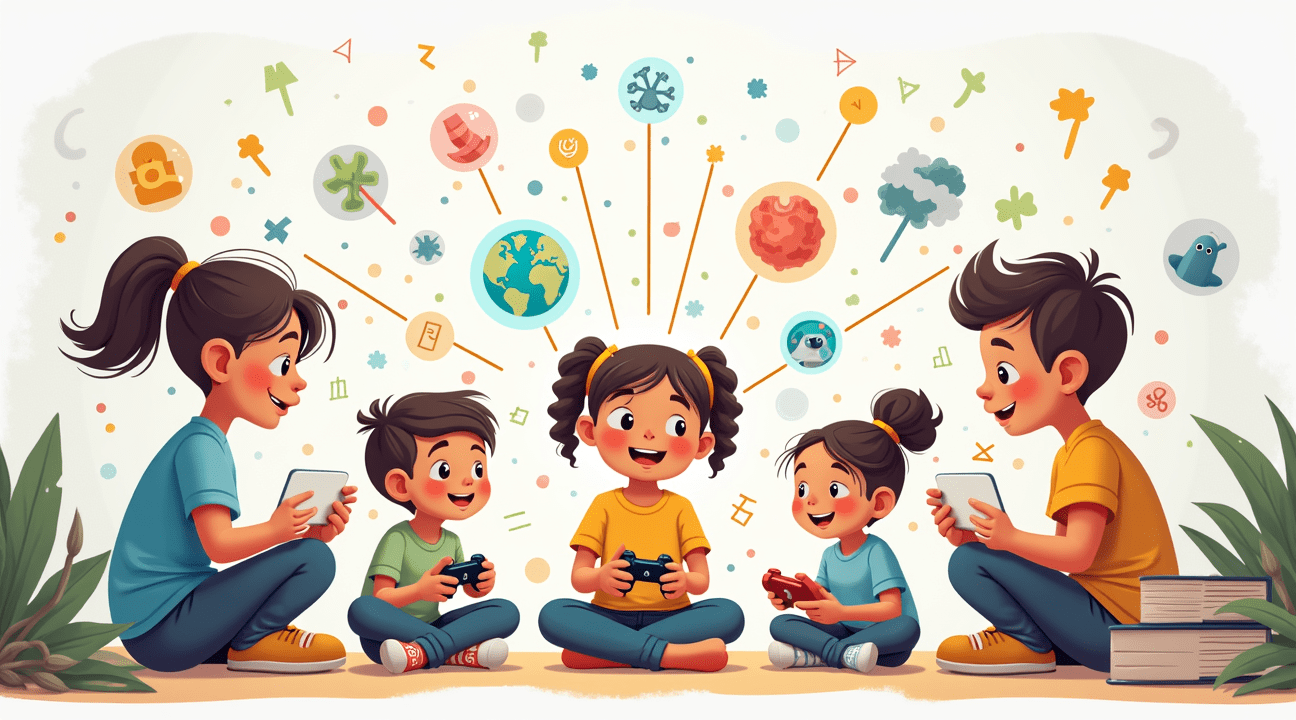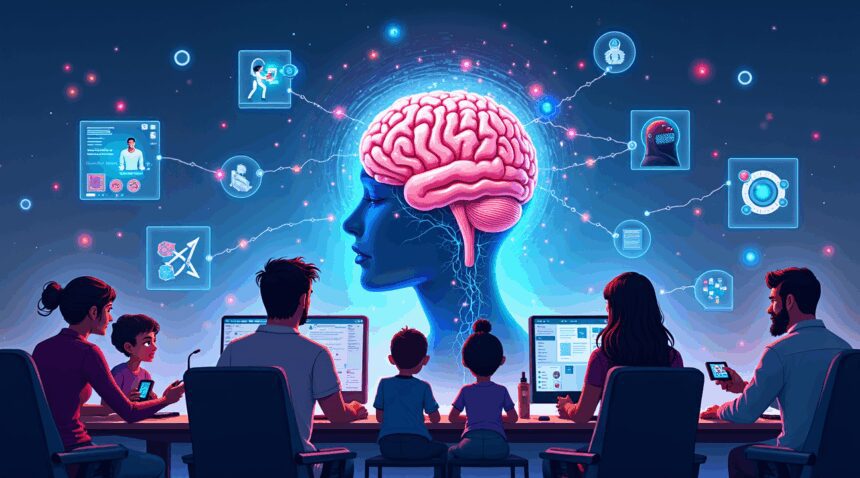Research consistently demonstrates that video games enhance cognitive performance across multiple domains, with gamers outperforming non-gamers in attention, mental flexibility, working memory, and problem-solving abilities.
Gaming is being increasingly recognized not just as entertainment, but as a powerful tool for medical intervention, stress relief, and fostering social connection. According to global studies, 71% of players report reduced stress levels. Furthermore, clinical trials have revealed significant benefits for both psychological and physical health outcomes.
Key Takeaways
- Cognitive Enhancement: Regular gaming improves fluid intelligence, working memory, and mental flexibility. Remarkably, frequent gamers perform cognitively like individuals 13.7 years younger than non-gamers.
- Physical Brain Changes: Video games increase gray matter density and enhance brain connectivity. These neural adaptations are often permanent, boosting cognitive reserves and helping protect against age-related mental decline.
- Clinical Medical Benefits: Gaming interventions contribute to a 69% improvement in psychological therapy outcomes and a 59% increase in physical rehabilitation success. These interventions have proven effective for managing anxiety, treating depression, reducing chronic pain, and improving motor function recovery.
- Stress Relief and Mental Wellness: Around 71% of gamers experience reduced stress, 68% report decreased anxiety, and 53% find relief from feelings of isolation through social gaming experiences.
- Social Skill Development: Contrary to stereotypes, gaming enhances children’s social skills and academic performance. Collaborative gameplay helps build communication, leadership qualities, and cultural awareness.
Video games are evolving into valuable tools for health, cognition, and community. Platforms like the American Psychological Association and ongoing research continue to support the integration of video games into therapy and development strategies.
How Video Games Actually Make Us Smarter Than We Think
Gaming transforms the brain in ways that many people don’t realize. Research consistently shows that video gamers outperform non-gamers across multiple cognitive domains, including attention, planning, mental flexibility, working memory, and visuospatial performance. These positive impacts extend far beyond entertainment, creating measurable improvements in how the brain processes information.
The relationship between gaming and intelligence appears to strengthen over time. Overall play time correlates positively with fluid intelligence, mental flexibility, visual and verbal working memory, and visuospatial performance. Simply put, the longer someone plays games, the better their cognitive accuracy and efficiency become. This challenges the outdated stereotype of gaming as a passive, mind-numbing activity.
The Age-Defying Power of Gaming
Recent large-scale research reveals something remarkable about frequent gamers. They performed cognitively like people 13.7 years younger on key tests compared to non-gamers. This suggests that gaming doesn’t just maintain cognitive function – it actively enhances it to levels typically seen in much younger individuals.
The cognitive advantages span multiple areas of brain function:
- Enhanced attention control and sustained focus during complex tasks
- Improved working memory capacity for processing multiple pieces of information
- Better visuospatial skills for understanding spatial relationships and navigation
- Increased mental flexibility for switching between different cognitive tasks
- Stronger fluid intelligence for solving novel problems without prior knowledge
A recent Brain and Body study provides important context for these findings. Video games notably boost cognitive abilities but don’t directly improve mental health, whereas physical exercise increases mental well-being without affecting cognitive performance. This distinction helps explain why gaming serves specific cognitive purposes that complement other healthy lifestyle choices.
The cognitive benefits appear across different types of games, though action games and strategy titles show particularly strong effects. Games that require quick decision-making, spatial reasoning, and multitasking seem to provide the most significant cognitive training. These skills transfer to real-world situations, improving performance in academic settings, professional environments, and daily problem-solving scenarios.
Understanding these cognitive benefits helps explain why gaming has become increasingly popular among people of all ages. The brain treats gaming as an intensive workout, strengthening neural pathways and building cognitive reserves that benefit long-term brain health.
The Science Behind Gaming’s Surprising Stress-Relief Powers
Gaming’s reputation as a stress-buster isn’t just anecdotal—it’s backed by substantial data that reveals how players worldwide turn to their controllers and keyboards for emotional relief. A comprehensive global survey involving nearly 13,000 active gamers across 12 countries uncovered compelling evidence about gaming’s therapeutic benefits, with 71% of respondents confirming that playing video games actively helps them feel less stressed.
The numbers become even more striking when examining specific regions. In the United States, 78% of gamers report stress reduction through gaming, while Brazil leads with an impressive 87% of players experiencing decreased stress levels. These statistics challenge outdated stereotypes about gaming being purely recreational, instead highlighting its genuine value as a positive impact tool for mental wellness.
Beyond Stress: Gaming’s Broader Emotional Benefits
Gaming’s therapeutic effects extend far beyond simple stress management. The same survey revealed that 68% of U.S. respondents experience reduced anxiety through gaming, while 53% find that games help combat feelings of isolation and loneliness by facilitating connections with others. This data supports what many players instinctively understand: games offer a unique blend of escapism and social interaction that traditional stress-relief methods often lack.
Players consistently emphasize the importance of connections and teamwork in their gaming experiences. Multiplayer and cooperative gaming modes create opportunities for meaningful social bonds, allowing individuals to collaborate with friends or strangers in shared virtual environments. These interactions often translate into reduced feelings of isolation, particularly valuable for those who might struggle with face-to-face social connections.
The science suggests that games tackle real-world problems by providing controlled environments where players can experience achievement, social connection, and stress relief simultaneously. Gaming offers immediate feedback systems, clear goals, and opportunities for mastery—elements that contribute to improved emotional wellbeing.
Research indicates that the interactive nature of gaming engages players in ways that passive entertainment cannot match. Unlike watching television or movies, gaming requires active participation and decision-making, which can redirect anxious thoughts and provide a sense of agency and control. This engagement creates what psychologists call “flow states”—periods of complete immersion that naturally reduce stress and anxiety levels.
The data demonstrates that gaming serves as more than entertainment; it functions as a legitimate tool for emotional regulation and social connection, offering measurable benefits for millions of players worldwide.
Why Your Brain Gets a Physical Upgrade From Gaming
I’ve discovered something remarkable about what happens inside your head when you pick up a controller. Studies reveal that playing video games actually increases gray matter in your brain while improving overall brain connectivity. This isn’t just entertainment—it’s a complete neural transformation happening with every gaming session.
Gray Matter Growth and Enhanced Brain Connectivity
Gray matter serves as the control center for muscle coordination, memory formation, perception, and spatial navigation. Research shows that regular gaming sessions literally expand these critical brain regions. Players develop denser neural networks that communicate more efficiently across different brain areas.
The connectivity improvements extend far beyond what researchers initially expected. Gamers show enhanced communication between the prefrontal cortex and other brain regions, creating faster information processing pathways. These changes persist even when players aren’t actively gaming, suggesting permanent improvements to brain architecture.
Gaming functions as a workout for your mind disguised as fun, pushing neural networks to adapt and strengthen. Each challenging level or complex puzzle forces the brain to create new connections and reinforce existing ones. Video games shape individuals through this continuous neural exercise, building cognitive reserves that benefit everyday activities.
Neuroplasticity and Long-Term Brain Health Benefits
Neuroplasticity—the brain’s ability to reorganize and form new neural connections—receives a significant boost through gaming activities. Action games particularly excel at promoting this adaptive capacity, forcing rapid decision-making and multi-tasking that strengthens neural flexibility. Strategy games enhance different aspects of plasticity by requiring long-term planning and resource management.
The brain health implications extend well into later life stages. Regular gamers show reduced age-related cognitive decline and maintain sharper mental acuity compared to non-gamers. Gaming’s impact on neuroplasticity creates a protective buffer against neurodegenerative conditions by maintaining active neural pathways.
Different game genres target specific brain regions, creating customized neural workouts:
- First-person shooters: Enhance visual processing and reaction times
- Puzzle games: Strengthen problem-solving networks
- Role-playing games: Develop memory systems and strategic thinking pathways
This variety ensures comprehensive brain development across multiple cognitive domains.
Research indicates that even moderate gaming sessions—just 30 minutes daily—can produce measurable brain changes within weeks. The key lies in consistent engagement with challenging content that pushes cognitive boundaries. Games tackle real-world problems by training the same neural networks used in professional and academic settings.
The physical brain changes from gaming persist long after players stop gaming, suggesting permanent neural adaptations. Functional MRI scans reveal increased brain volume in areas responsible for fine motor skills, strategic planning, and memory formation. These structural improvements translate into enhanced performance across various cognitive tasks.
Gaming’s neuroplasticity benefits appear strongest during adolescence and early adulthood when brain development remains most active. However, older adults also experience significant improvements, demonstrating the brain’s lifelong capacity for growth and adaptation through engaging digital experiences.

Gaming as Medical Treatment: The Clinical Evidence
Scientific research has firmly established video games as legitimate medical interventions, with clinical trials demonstrating measurable health improvements across multiple therapeutic areas. A comprehensive review of randomized controlled trials revealed that video games enhanced 69% of psychological therapy outcomes, making them particularly effective for treating mental health conditions like anxiety, depression, and PTSD.
Physical Rehabilitation and Pain Management
Physical therapy programs incorporating video game interventions showed remarkable success rates, with 59% of outcomes improving compared to traditional treatment methods alone. These gains extend beyond simple engagement—patients using gaming-based rehabilitation demonstrated better motor function recovery, improved balance, and faster return to daily activities.
Gaming’s impact on pain management represents another significant breakthrough in clinical applications. Studies documented a 42% improvement in pain distraction when patients used video games during medical procedures or chronic pain episodes. This natural analgesic effect reduces reliance on pharmaceutical interventions while providing patients with an active coping mechanism.
Chronic Disease Management and Physical Activity
Patients managing chronic conditions experienced a 37% improvement in self-management behaviors when video games were integrated into their care plans. These improvements included:
- Better medication adherence
- More consistent monitoring of vital signs
- Increased engagement with treatment protocols
Video games positively impact patient motivation by transforming routine medical tasks into engaging, goal-oriented activities.
Physical activity outcomes also benefited significantly from gaming interventions, with 50% of programs showing improved results. Motion-controlled games and virtual reality fitness applications encourage movement in patients who might otherwise remain sedentary due to mobility limitations or lack of motivation. These platforms provide safe environments for exercise while offering real-time feedback and progress tracking.
Healthcare providers increasingly recognize gaming as a versatile therapeutic tool that addresses multiple treatment goals simultaneously. Unlike traditional interventions that often focus on single outcomes, video game therapy can improve:
- Cognitive function
- Physical coordination
- Emotional regulation
- Social interaction
These unified treatment experiences enable a multi-faceted approach that proves especially valuable for complex conditions requiring comprehensive rehabilitation strategies.
The clinical evidence supporting video game interventions continues expanding as healthcare institutions integrate gaming technologies into standard care protocols. Games tackle real-world problems by offering scalable, cost-effective treatment options that engage patients more effectively than conventional methods. These measurable improvements in therapeutic outcomes position gaming as an essential component of modern medical practice rather than merely supplemental entertainment.

Breaking the Antisocial Gamer Myth: How Games Build Better Relationships
The stereotype of the isolated gamer hunched over a screen, disconnected from the world, couldn’t be further from reality. Modern research reveals a completely different picture, showing that gaming actually enhances social development and strengthens interpersonal connections in ways that traditional activities often can’t match.
Research Reveals Gaming’s Social Benefits
Children who engage with video games consistently demonstrate enhanced social skills compared to their non-gaming peers. These findings challenge decades of misconceptions about gaming culture and highlight how video games positively impact personality development. Academic performance also sees improvement among regular players, suggesting that gaming develops cognitive abilities that transfer to educational settings.
The collaborative elements built into most modern games create natural opportunities for skill development. Players must communicate effectively, coordinate strategies, and resolve conflicts—all essential components of healthy relationship building. These interactions happen organically within gaming environments, making social learning feel natural rather than forced.
Global Gaming Communities Foster Connection
International surveys consistently show that players prioritize meaningful connections over individual achievement. The data reveals several key areas where gaming strengthens social bonds:
- Communication skills develop through real-time coordination with team members across different time zones and cultures
- Conflict resolution improves as players learn to handle disagreements and find compromises during challenging gameplay moments
- Leadership abilities emerge when players take charge of guilds, raid groups, or competitive teams
- Empathy grows through shared experiences and supporting struggling teammates
- Cultural awareness expands as players interact with diverse global communities
Multiplayer and cooperative gaming modes specifically support these social developments. Players learn to adapt their communication styles to different personalities, manage group dynamics, and celebrate collective achievements. These experiences mirror real-world professional environments where teamwork and collaboration determine success.
The persistence of gaming relationships often surprises non-players. Many gaming partnerships evolve into lasting friendships that extend beyond virtual environments. Players frequently organize meetups, attend conventions together, and maintain contact through various platforms long after specific games lose their appeal.
Communication platforms integrated into gaming systems further enhance these connections. Voice chat, text messaging, and social features allow players to share experiences, offer support, and maintain relationships between gaming sessions. This constant connectivity helps prevent the isolation that critics often associate with gaming culture.
Gaming’s problem-solving nature also contributes to relationship building. Players who successfully navigate complex challenges together develop trust and mutual respect. These shared accomplishments create strong emotional bonds and lasting memories that strengthen social connections.
The strategic thinking required in many games translates directly to improved social awareness. Players develop better understanding of group dynamics, learn to anticipate others’ needs, and become more skilled at reading social cues. These abilities prove invaluable in educational settings, workplace environments, and personal relationships.
Professional gaming and streaming communities demonstrate how gaming skills transfer to career success. Content creators who started as casual players often develop impressive presentation abilities, audience engagement techniques, and business management skills through their gaming experiences.
Educational institutions increasingly recognize these benefits and integrate gaming concepts into curricula. Schools use collaborative gaming projects to teach teamwork, communication, and problem-solving skills that traditional methods struggle to develop as effectively.
The social infrastructure of gaming continues evolving with new technologies. Virtual reality and augmented reality platforms create even more immersive collaborative experiences, while mobile gaming brings social connectivity to previously untapped audiences. These developments suggest that gaming’s role in relationship building will only grow stronger over time.
Parents and educators who understand these dynamics can better support young gamers’ development. Rather than limiting screen time arbitrarily, they can encourage participation in positive gaming communities and help children recognize how gaming skills apply to offline situations.
The Game Design Factor: Why Not All Gaming Benefits Are Created Equal
I can’t stress enough how crucial thoughtful game design becomes when examining gaming’s positive effects on children. Digital games that prioritize proper design principles actively promote a child’s well-being by supporting four key developmental areas: autonomy, competence, creativity, and identity formation.
UNICEF and NYU research reveals a fundamental truth about gaming benefits—they aren’t automatically present in every title. Games that align closely with children’s specific interests and developmental needs consistently yield the most positive outcomes. This finding highlights why parents and educators can’t simply assume all games provide equal benefits.
Core Elements That Drive Positive Gaming Experiences
The most beneficial games incorporate several essential design elements that directly support child development:
- Autonomy-building features that give players meaningful choices and control over their gaming experience
- Competence scaffolding through progressive difficulty systems that challenge without overwhelming
- Creative expression tools that encourage original thinking and problem-solving approaches
- Identity exploration opportunities through character customization and role-playing scenarios
- Social interaction systems that promote healthy communication and collaboration
Games that lack these foundational elements often fail to deliver the cognitive and emotional benefits that video games can have on individuals. I’ve observed that titles focused solely on entertainment value without considering developmental impact rarely produce lasting positive effects.
The distinction becomes even more important when considering how games tackle real-world problems. Well-designed educational games can teach complex subjects like environmental science, history, or mathematics while maintaining engagement levels that traditional teaching methods often struggle to achieve.
Responsible game design also considers age-appropriate content delivery. Games that successfully support child development present challenges gradually, allowing players to build confidence and skills incrementally. This approach contrasts sharply with games that prioritize addictive mechanics over educational value or personal growth.
Research consistently shows that children benefit most from games that respect their intelligence while providing appropriate guidance. The best examples offer rich narratives that encourage critical thinking, puzzle-solving mechanics that develop logical reasoning, and social features that promote positive interpersonal skills.
I find it particularly noteworthy that the gaming industry has begun recognizing this responsibility more seriously. Developers increasingly consider child psychology and learning theory during the design process, creating experiences that entertain while genuinely contributing to cognitive and emotional development.
The evidence suggests that parents should evaluate games based on their design philosophy rather than dismissing gaming entirely. Quality games can supplement traditional learning methods effectively, especially for children who respond well to interactive, hands-on experiences.
This emphasis on intentional design explains why gaming preferences vary so significantly among different demographics. Studies indicate that many people prefer games over traditional media, largely because interactive experiences provide agency and engagement that passive entertainment cannot match.
The most successful games in terms of positive impact combine entertainment value with meaningful learning opportunities. They create environments where children can experiment, fail safely, learn from mistakes, and celebrate achievements in ways that build genuine confidence and resilience.
Understanding this design factor becomes crucial for anyone interested in maximizing gaming’s positive potential. Rather than viewing all games as equal, I recommend focusing on titles that demonstrate clear commitment to supporting player growth and development through thoughtful, research-based design principles.

Sources:
“Global Report Reveals Positive Benefits of Video Gameplay,” The Entertainment Software Association (ESA)
“Video games and board games: Effects of playing practice on cognitive abilities,” L Martinez et al., PMC
“Role of Video Games in Improving Health-Related Outcomes: A Systematic Review,” PMC
“Association of Video Gaming With Cognitive Performance Among Children,” JAMA Network Open
“Benefits of Video Games For Kids & Adults,” GEICO Living
“Western-led study shows playing video games may improve cognition, but not mental health,” Western University News
“Video games can have a positive impact on children—if designed with their needs in mind,” NYU/UNICEF Innocenti RITEC project
“Video Games Boost Cognition, Exercise Improves Mental Well-Being, Large-Scale Study Finds,” NeuroScienceNews/University of Western Ontario


